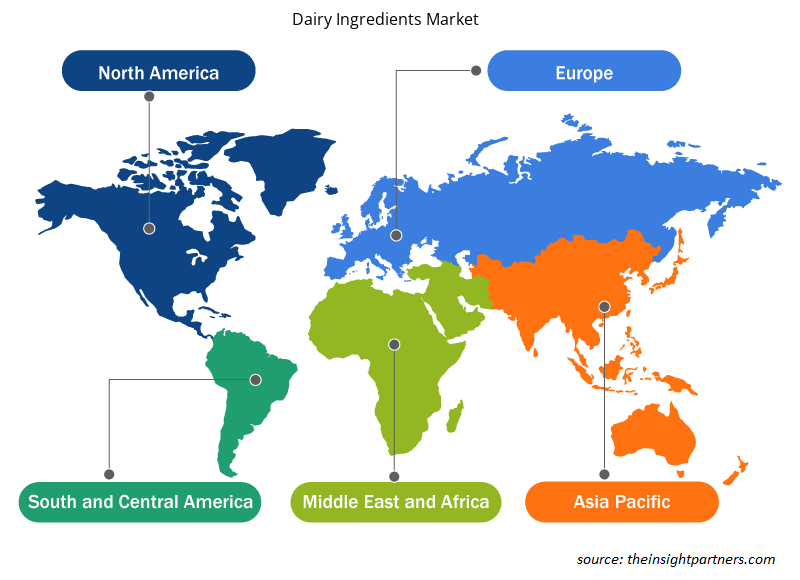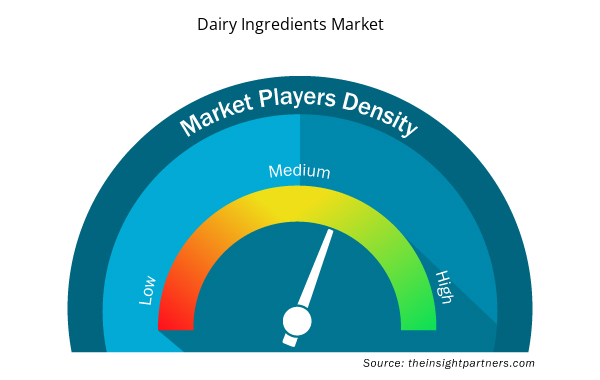2021 年乳制品原料市场价值为 856.8415 亿美元,预计到 2028 年将达到 1052.9516 亿美元。预计 2021 年至 2028 年的复合年增长率为 3.0%。
乳制品成分富含蛋白质、氨基酸、碳水化合物、矿物质和维生素以及益生菌。乳制品成分用于各种食品和饮料,包括烘焙产品、糖果、冰淇淋、乳制品、甜点、香料混合物和干烘焙混合物。乳蛋白用于蛋白质补充剂和功能性食品。此外,乳制品成分还用于个人护理产品,因为它们可以为皮肤和头发提供水分。此外,乳制品蛋白还用于动物饲料中,以强化饲料,满足牲畜的营养需求。
2020 年,亚太地区占据了全球乳制品原料市场的最大份额,而中东和非洲市场预计在预测期内将以最快的复合年增长率增长。印度是该地区最大的乳制品生产国之一。根据粮食及农业组织 (FAO) 的数据,印度占全球牛奶产量的 22%。该地区拥有成熟的乳制品行业是推动该地区市场增长的主要因素之一。此外,由于人们越来越关注健康和福祉,对功能性食品和饮料以及蛋白质补充剂的需求不断增长,也是推动亚太乳制品原料市场增长的重要因素。
定制此报告以满足您的需求
您可以免费定制任何报告,包括本报告的部分内容、国家级分析、Excel 数据包,以及为初创企业和大学提供优惠和折扣
- 获取此报告的关键市场趋势。这个免费样品将包括数据分析,从市场趋势到估计和预测。
COVID-19 疫情对乳制品原料市场的影响
COVID-19 疫情影响了许多行业,包括食品和饮料行业。疫情导致封锁、企业停工和供应链中断,造成了运营困难。由于劳动力和原材料短缺,乳制品行业也受到了影响。然而,由于人们对健康和健身的认识不断提高,对功能性食品和饮料的需求增加,这为乳制品原料市场提供了积极的增长机会。此外,由于人们对增强免疫力产品的偏好不断增加,对膳食补充剂的需求也增加了。这一因素也积极地促进了市场增长。此外,预计疫苗接种率的上升、制造业活动的复苏以及政府监管的放宽将在预测期内对全球乳制品原料市场产生积极影响。
市场洞察
乳制品行业增长推动乳制品原料市场
全球乳制品行业正在经历显著的增长。根据联合国粮食及农业组织 (FAO) 的数据,2021 年全球牛奶产量为 9.28 亿吨。人口的增长和人们饮食的变化可能会推动乳制品行业的增长。此外,快速的城市化、可支配收入的增加以及对富含蛋白质、营养丰富的食品的偏好日益增加也在推动乳制品行业的发展。此外,乳制品行业正在经历技术转型。制造商使用区块链、机器人和支持 GPS 的设备等新兴技术来优化乳制品生产。这些因素正在推动乳制品行业的增长,这可能会在预测期内推动乳制品原料市场的增长。
产品类型洞察
根据产品类型,全球乳制品原料市场细分为蛋白质、奶粉、浓缩乳脂、乳糖和乳糖衍生物等。预计蛋白质部分将在 2021-2028 年预测期内实现显着增长。酪蛋白和乳清蛋白是牛奶中的主要蛋白质。酪蛋白广泛用于婴儿营养产品和婴儿食品。乳清蛋白用于制造蛋白质补充剂。乳清蛋白还用于功能性食品和饮料中以增强营养。对富含蛋白质的食品的需求不断增长,推动了对牛奶蛋白的需求。此外,由于人们对特定婴儿营养的认识不断提高,制造婴儿食品对牛奶蛋白的需求不断增长,这也推动了该细分市场的增长。
应用程序洞察
根据应用,乳制品成分市场细分为食品和饮料、药品和保健食品、动物饲料和个人护理。食品和饮料部门在 2020 年占据了最大的市场份额。乳制品成分被广泛用于各种食品和饮料中,包括面包、蛋糕、糕点、松饼、冰淇淋、巧克力、奶酪和奶油。由于可支配收入增加、快速城市化、对健康和健身的倾向增加以及对方便食品的需求增加,食品和饮料行业迅速增长,是推动乳制品成分市场增长的关键因素。此外,保健食品行业对乳蛋白的需求不断增加,预计也将在未来几年推动该部门的增长。
乳制品原料市场的一些参与者包括 Agropur、Arla Foods Ingredients Group P/S、Lactalis Ingredients、Frieslandcampina、Saputo Inc.、Fonterra Co-Operative Group Limited、Kerry、Amco Proteins、Prolactal 和 Glanbia Ireland 等。
乳制品原料市场区域洞察
Insight Partners 的分析师已详尽解释了预测期内影响乳制品原料市场的区域趋势和因素。本节还讨论了北美、欧洲、亚太地区、中东和非洲以及南美和中美洲的乳制品原料市场细分和地理位置。

- 获取乳制品原料市场的区域特定数据
乳制品原料市场报告范围
| 报告属性 | 细节 |
|---|---|
| 2021 年市场规模 | 856.8亿美元 |
| 2028 年市场规模 | 1053亿美元 |
| 全球复合年增长率(2021 - 2028) | 3.0% |
| 史料 | 2019-2020 |
| 预测期 | 2022-2028 |
| 涵盖的领域 | 按产品类型
|
| 覆盖地区和国家 | 北美
|
| 市场领导者和主要公司简介 |
|
乳制品原料市场参与者密度:了解其对业务动态的影响
乳制品原料市场正在快速增长,这得益于终端用户需求的不断增长,而这些需求又源于消费者偏好的不断变化、技术进步以及对产品优势的认识不断提高等因素。随着需求的增加,企业正在扩大其产品范围,进行创新以满足消费者的需求,并利用新兴趋势,从而进一步推动市场增长。
市场参与者密度是指在特定市场或行业内运营的企业或公司的分布情况。它表明在给定市场空间中,相对于其规模或总市场价值,有多少竞争对手(市场参与者)存在。
在乳制品原料市场运营的主要公司有:
- 菲仕兰坎皮纳成分。
- 恒天然合作集团有限公司
- Arla 食品配料集团
- Lactalis 成分
- 农业普尔
免责声明:上面列出的公司没有按照任何特定顺序排列。

- 获取乳制品原料市场顶级关键参与者概览
报告亮点
- 乳制品原料市场的渐进式行业趋势可帮助参与者制定有效的长期战略
- 发达市场和发展中市场采用的业务增长战略
- 2019 年至 2028 年乳制品原料市场定量分析
- 全球乳制品原料需求量估计
- 波特的五力分析说明了行业中买家和供应商的效力
- 了解竞争市场状况的最新发展
- 市场趋势和前景以及推动和抑制乳制品原料市场增长的因素
- 通过强调支撑商业利益的市场策略来协助决策过程,从而促进市场增长
- 不同节点乳制品原料市场规模
- 市场详细概述和细分,以及乳制品原料行业动态
- 各地区乳制品原料市场规模及增长潜力巨大
- 历史分析(2 年)、基准年、预测(7 年)及复合年增长率
- PEST 和 SWOT 分析
- 市场规模价值/数量 - 全球、区域、国家
- 行业和竞争格局
- Excel 数据集



Report Coverage
Revenue forecast, Company Analysis, Industry landscape, Growth factors, and Trends

Segment Covered
This text is related
to segments covered.

Regional Scope
North America, Europe, Asia Pacific, Middle East & Africa, South & Central America

Country Scope
This text is related
to country scope.
常见问题
With the rapid growth of the dairy industry, the demand for dairy ingredients such as milk powder, lactose and its derivatives, milk protein, etc., is also growing. surging dairy production, the dairy ingredients market is also projected to register a notable growth over the forecast period.
Asia-Pacific accounted for the largest share of the global dairy ingredients market. The surge in demand for dairy ingredients in the food & beverage and nutraceutical industry to drive the dairy ingredients market in the region.
The dairy ingredients are a major constituent of nutritious food and supplements. It gets widely used in probiotic foods, protein supplements. Whey protein is often sold as a protein supplement, and it has been associated to a variety of health benefits. Due to these properties, manufacturers of pharmaceutical and nutraceutical products frequently employ dairy ingredients in their products.
Dairy ingredients have a wide range of applications across several end-use industries including food and beverage, pharmaceuticals and nutraceuticals, personal care, and animal feed is expected to create lucrative opportunities for dairy ingredients market in the coming years.
Based on application, the food and beverage segment accounted for the largest revenue share as the dairy ingredients essentially thrive on the wider functional benefits that these ingredients confer, in terms of high quality, safety, and nutrition of the processed food products. Processed food products include various categories, such as baked products, confectionary, and beverages.
The major players operating in the global dairy ingredients market are FrieslandCampina Ingredient., Fonterra Co-operative Group Limited, Arla Foods Ingredients Group P/S, Lactalis Ingredients, AGROPUR, Saputo Inc., Kerry Group, AMCO Proteins, PROLACTAL, Glanbia Ireland.
Trends and growth analysis reports related to Food and Beverages : READ MORE..
The List of Companies - Dairy Ingredients Market
- FrieslandCampina Ingredient.
- Fonterra Co-operative Group Limited
- Arla Foods Ingredients Group P/S
- Lactalis Ingredients
- AGROPUR
- Saputo Inc.
- Kerry Group
- AMCO Proteins
- PROLACTAL
- Glanbia Ireland
The Insight Partners performs research in 4 major stages: Data Collection & Secondary Research, Primary Research, Data Analysis and Data Triangulation & Final Review.
- Data Collection and Secondary Research:
As a market research and consulting firm operating from a decade, we have published and advised several client across the globe. First step for any study will start with an assessment of currently available data and insights from existing reports. Further, historical and current market information is collected from Investor Presentations, Annual Reports, SEC Filings, etc., and other information related to company’s performance and market positioning are gathered from Paid Databases (Factiva, Hoovers, and Reuters) and various other publications available in public domain.
Several associations trade associates, technical forums, institutes, societies and organization are accessed to gain technical as well as market related insights through their publications such as research papers, blogs and press releases related to the studies are referred to get cues about the market. Further, white papers, journals, magazines, and other news articles published in last 3 years are scrutinized and analyzed to understand the current market trends.
- Primary Research:
The primarily interview analysis comprise of data obtained from industry participants interview and answers to survey questions gathered by in-house primary team.
For primary research, interviews are conducted with industry experts/CEOs/Marketing Managers/VPs/Subject Matter Experts from both demand and supply side to get a 360-degree view of the market. The primary team conducts several interviews based on the complexity of the markets to understand the various market trends and dynamics which makes research more credible and precise.
A typical research interview fulfils the following functions:
- Provides first-hand information on the market size, market trends, growth trends, competitive landscape, and outlook
- Validates and strengthens in-house secondary research findings
- Develops the analysis team’s expertise and market understanding
Primary research involves email interactions and telephone interviews for each market, category, segment, and sub-segment across geographies. The participants who typically take part in such a process include, but are not limited to:
- Industry participants: VPs, business development managers, market intelligence managers and national sales managers
- Outside experts: Valuation experts, research analysts and key opinion leaders specializing in the electronics and semiconductor industry.
Below is the breakup of our primary respondents by company, designation, and region:

Once we receive the confirmation from primary research sources or primary respondents, we finalize the base year market estimation and forecast the data as per the macroeconomic and microeconomic factors assessed during data collection.
- Data Analysis:
Once data is validated through both secondary as well as primary respondents, we finalize the market estimations by hypothesis formulation and factor analysis at regional and country level.
- Macro-Economic Factor Analysis:
We analyse macroeconomic indicators such the gross domestic product (GDP), increase in the demand for goods and services across industries, technological advancement, regional economic growth, governmental policies, the influence of COVID-19, PEST analysis, and other aspects. This analysis aids in setting benchmarks for various nations/regions and approximating market splits. Additionally, the general trend of the aforementioned components aid in determining the market's development possibilities.
- Country Level Data:
Various factors that are especially aligned to the country are taken into account to determine the market size for a certain area and country, including the presence of vendors, such as headquarters and offices, the country's GDP, demand patterns, and industry growth. To comprehend the market dynamics for the nation, a number of growth variables, inhibitors, application areas, and current market trends are researched. The aforementioned elements aid in determining the country's overall market's growth potential.
- Company Profile:
The “Table of Contents” is formulated by listing and analyzing more than 25 - 30 companies operating in the market ecosystem across geographies. However, we profile only 10 companies as a standard practice in our syndicate reports. These 10 companies comprise leading, emerging, and regional players. Nonetheless, our analysis is not restricted to the 10 listed companies, we also analyze other companies present in the market to develop a holistic view and understand the prevailing trends. The “Company Profiles” section in the report covers key facts, business description, products & services, financial information, SWOT analysis, and key developments. The financial information presented is extracted from the annual reports and official documents of the publicly listed companies. Upon collecting the information for the sections of respective companies, we verify them via various primary sources and then compile the data in respective company profiles. The company level information helps us in deriving the base number as well as in forecasting the market size.
- Developing Base Number:
Aggregation of sales statistics (2020-2022) and macro-economic factor, and other secondary and primary research insights are utilized to arrive at base number and related market shares for 2022. The data gaps are identified in this step and relevant market data is analyzed, collected from paid primary interviews or databases. On finalizing the base year market size, forecasts are developed on the basis of macro-economic, industry and market growth factors and company level analysis.
- Data Triangulation and Final Review:
The market findings and base year market size calculations are validated from supply as well as demand side. Demand side validations are based on macro-economic factor analysis and benchmarks for respective regions and countries. In case of supply side validations, revenues of major companies are estimated (in case not available) based on industry benchmark, approximate number of employees, product portfolio, and primary interviews revenues are gathered. Further revenue from target product/service segment is assessed to avoid overshooting of market statistics. In case of heavy deviations between supply and demand side values, all thes steps are repeated to achieve synchronization.
We follow an iterative model, wherein we share our research findings with Subject Matter Experts (SME’s) and Key Opinion Leaders (KOLs) until consensus view of the market is not formulated – this model negates any drastic deviation in the opinions of experts. Only validated and universally acceptable research findings are quoted in our reports.
We have important check points that we use to validate our research findings – which we call – data triangulation, where we validate the information, we generate from secondary sources with primary interviews and then we re-validate with our internal data bases and Subject matter experts. This comprehensive model enables us to deliver high quality, reliable data in shortest possible time.


 获取此报告的免费样本
获取此报告的免费样本